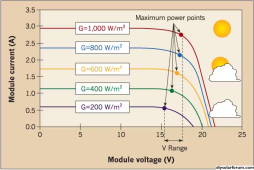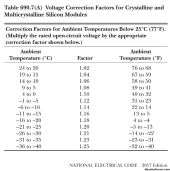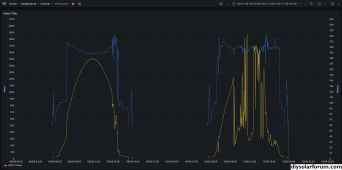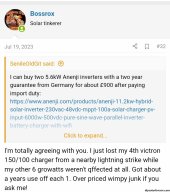You are using an out of date browser. It may not display this or other websites correctly.
You should upgrade or use an alternative browser.
You should upgrade or use an alternative browser.
Victron is Over-priced Eurotrash. Why would anybody buy Victron over an AiO?
- Thread starter sunshine_eggo
- Start date
sunshine_eggo
Happy Breffast!
All their chargers have overvolt shutdown but I'm using the SC48120-MPV's & they don't mention it in the specs but I had an overvolt shutdown happen presumably from a solar flare that jacked my panels past their normal VOC.
Huh? Now it sounds like you're making stuff up. The presence of light gives voltage. The intensity of light gives amps. A solar flare would result in greater intensity resulting in more power/current and likely LOWER voltage due to increased cell heating from higher intensity solar irradiance.
Sounds to me like you're pushing your controllers to the Voc limit and beyond.
Bossrox
Solar tinkerer
You're starting to get on my nerves! No dummie, a solar flare raises the voltage & likely the amps too, show me where that's not true, not just you're opinion.Huh? Now it sounds like you're making stuff up. The presence of light gives voltage. The intensity of light gives amps. A solar flare would result in greater intensity resulting in more power/current and likely LOWER voltage due to increased cell heating from higher intensity solar irradiance.
Sounds to me like you're pushing your controllers to the Voc limit and beyond.
sunshine_eggo
Happy Breffast!
You're starting to get on my nerves! No dummie, a solar flare raises the voltage & likely the amps too, show me where that's not true, not just you're opinion.
You're making the claim. The burden of proof is on you, but I'll help you out. Here's a reference (check your panel datasheet, you should see similar data):

The Highs and Lows of Photovoltaic System Calculations
Understanding calculations for proper system design and installation of photovoltaic (PV) systems

200W/m2 = 18Voc
400W/m2 = 20Voc (2X the intensity)
600W/m2 = 21Voc (3X the intensity)
800W/m2 = 21.5Voc (4X the intensity)
1000W/m2 = 22Voc (5X the intensity)
5X increase in intensity = 22% increase in Voc based on idealized data. In the MPPT range it's barely 10% (Vmp)
5X increase in intensity = 480% increase in Isc based on idealized data. It's a comparable relationship in the Imp range.
I hope this makes it very clear to you that there isn't a "likely" increase in amps. It's a definite, and it's massive. On a relative basis, the influence of irradiance on current is 22X greater than its influence on voltage, hence: light gives voltage; intensity of light gives current.
Of note - 2X increase from 400 to 800 only produces an 8% increase. The trend is clear. The rate of voltage increase decreases as irradiance increases.
"idealized data" = STC conditions - rarely exist in real life. On most sunny days, your panels aren't going to be at 25°C, they're going to be 40-50°C because 80% of the energy hitting them is being converted directly to heat, and are already running about 8% below Voc/Vmp.
At higher irradiance levels a major flare that would double the irradiance would have an even lesser effect. Double the irradiance from 1000 to 2000, and you're only going to get a 5-10% increase in voltage - which will likely not overcome the already suppressed voltage due to elevated cell temperature.
You clearly don't understand how environmental conditions affect PV modules. I am now absolutely convinced that you put 3S 72 cell panels on your Victron MPPT, and you popped them, and of course Victron wouldn't warranty them because you abused them. The obvious fix was to go with a higher Voc rated MPPT...that you still manage to over-volt.
You have a responsibility to design your system within the hardware and environmental limitations. When you do it wrong, it's not the equipment's fault.
wattmatters
Solar Wizard
Apart from the 1300 GW of globally installed solar PV capacity which has managed to survive all these solar flares...& of course there's no stats on how they react to solar flares
Brucey
Solar Wizard
Brucey
Solar Wizard
Or adding additional panels based on sun conditions? Perhaps flying to close to the sun...

 diysolarforum.com
diysolarforum.com

Over paneling my chargers using solar switches to keep charger inputs to normal.
I have 2 Systems, A 24v & 48v. The 48v is using 2 Growatt 80 amp chargers rated for 5kw each. The 24v is using 2 victron 150/100's @ 3kw each. So I have chargers with a total input capacity of 16kw & 22.5 kw in solar panels feeding them. In these videos I attempt to explain how I'm adding extra...
Samsonite801
Solar Wizard
- Joined
- Oct 15, 2020
- Messages
- 2,993
Maybe it was a lightning strike ...
Maybe should look into a SPD for the PV circuit...
Bossrox
Solar tinkerer
Just to set the record on whether a solar flare can overvolt a charger, here's a post from a member that recorded a solar flare https://diysolarforum.com/threads/july-17-solar-flare-event.65867/ so yeah, if your volt input to your charger is not far off from it's limit, a flare can push it over the top. At max volts, I'm about 25 volts away from my chargers max volt input & a flare will run it into overvolts as my chargers have shown by shutting down during such events & sometimes on cloud edging too.Apart from the 1300 GW of globally installed solar PV capacity which has managed to survive all these solar flares...
Brucey
Solar Wizard
Are you still running the setup shown in your videos where you switch in additional panels during low solar times? Potentially this is what smoked your three or four Victron 150/100s?Just to set the record on whether a solar flare can overvolt a charger, here's a post from a member that recorded a solar flare https://diysolarforum.com/threads/july-17-solar-flare-event.65867/ so yeah, if your volt input to your charger is not far off from it's limit, a flare can push it over the top. At max volts, I'm about 25 volts away from my chargers max volt input & a flare will run it into overvolts as my chargers have shown by shutting down during such events & sometimes on cloud edging too.
timselectric
If I can do it, you can do it.
- Joined
- Feb 5, 2022
- Messages
- 19,104
When you choose to live on the edge.
You have to be prepared to suffer the consequences of going over that edge.
You have to be prepared to suffer the consequences of going over that edge.
WestAus
New Member
Victron OFG-VIC10 = ~$7,000.00 (au$)
Vs.
Ecgsolax MAX-10.2K = ~$850.00 (au$)
I could buy 8 x with change. But likely by the time the 1st needs replacing, like cell phones, tech will have improved.
Vs.
Ecgsolax MAX-10.2K = ~$850.00 (au$)
I could buy 8 x with change. But likely by the time the 1st needs replacing, like cell phones, tech will have improved.
sunshine_eggo
Happy Breffast!
& of course there's no stats on how they react to solar flares so you wasted your time for nothing & proved nothing. Go to bed, your brain is foggy.
Your inability to interpret basic information and simple arithmetic shouldn't be confused with me somehow being foggy.
You know that solar flares aren't magic, right? It's just more sun. The only question is how much and for how long.
Just to set the record on whether a solar flare can overvolt a charger, here's a post from a member that recorded a solar flare https://diysolarforum.com/threads/july-17-solar-flare-event.65867/
Can you read or interpret technical data? Where do you see volts? That's power.
I've addressed the power issue above. A doubling of the irradiance would nearly double the current. Double current = double power at the same voltage.
so yeah, if your volt input to your charger is not far off from it's limit, a flare can push it over the top. At max volts, I'm about 25 volts away from my chargers max volt input & a flare will run it into overvolts as my chargers have shown by shutting down during such events & sometimes on cloud edging too.
You just admitted to a poor design. PVWatts (which actually reports hourly temperature data) says Columbia, SC can get as low as 21°F, and according to news reports... -1°F

Coldest Temperature on Record in Columbia - ABC Columbia
36 years ago today, Columbia recorded its coldest temperature on record. On January 21, 1985, the temperature dipped to -1°. Yikes! Reliable temperature records go back about 150 years. Categories: Weather Blog
But that's outside the 30 year window that PVWatts uses, so I'll give you a pass.
You should have AT LEAST 14% Voc margin:

On a 150V controller that's 21V.
On a 200V controller, that's 28V.
On a 250V controller, that's 35V.
You should consider that this may be one of those situations where your vast electrical experience and knowledge takes a back seat to science, manufacturer's specifications and well... reality.
You killed Victron controllers because you overvolted them.
Victron refused warranty because you misused their equipment by overvolting them.
As I've claimed before, your experience with Victron hardware is atypical in the extreme... However, it is VERY common for someone who can't properly design a system within equipment specifications.
Brett V
Mad Scientist
But it's so much more interesting!When you choose to live on the edge.
You have to be prepared to suffer the consequences of going over that edge.
timselectric
If I can do it, you can do it.
- Joined
- Feb 5, 2022
- Messages
- 19,104
Oh, I agree that it is.But it's so much more interesting!
But, you can't complain when it bites you in the ass.
wattmatters
Solar Wizard
Looks no different to a cloud edge effect to me. And nowhere does that show a voltage spike occurring. That would be pretty unlikely, as that's not what happens when irradiance rapidly increases.Just to set the record on whether a solar flare can overvolt a charger, here's a post from a member that recorded a solar flare https://diysolarforum.com/threads/july-17-solar-flare-event.65867/ so yeah, if your volt input to your charger is not far off from it's limit, a flare can push it over the top.
Example, compare PV output for a two recent consecutive days:

The first day is a nice clear sunny day. The second day had lots of clouds passing over with patches of sun.
The first day shows the typical peak power curve (yellow line) during the middle of the day for an unconstrained PV array.
Note on the second day the significantly higher power outputs resulting from cloud edge effects.
Now look at the MPPT voltage (blue line). These shorter term peaks in irradiance do not result in a voltage spike.
What happens is the array current goes up. Here's the same chart with the MPPT current (purple line) showing:

Note how it's the array amps which rise and fall with those sharp increases in irradiance, while MPPT voltage doesn't react much.
wattmatters
Solar Wizard
”In God we trust. All others must bring data.” - W. Edwards Demingyou're a data nerd that relies on charts you think are right but I have the real life witnessing of events & seeing the events
I have real life witnessing as well backed up by actually recording the data.
KITROBASKIN
Solar Enthusiast
No time wasted here because others (including myself) are interested in learning about the details sunshine put forth.& of course there's no stats on how they react to solar flares so you wasted your time for nothing & proved nothing. Go to bed, your brain is foggy.
Interesting. I wonder how so many over paneled growatts have been fried then. Their numbers are hard numbers without bufferAll their chargers have overvolt shutdown but I'm using the SC48120-MPV's & they don't mention it in the specs but I had an overvolt shutdown happen presumably from a solar flare that jacked my panels past their normal VOC.
To be fair. Though. Your comparison is also not like for like.
You went from a 150v Victron to a 250v Growatt. Imagine what you could do with a 250v Victron
Last edited:
Nobody should be running VOC with such minimal buffer that in JULY you exceed the charge controller specs from a solar flare…what ever would your system do on a cold bright January day?Just to set the record on whether a solar flare can overvolt a charger, here's a post from a member that recorded a solar flare https://diysolarforum.com/threads/july-17-solar-flare-event.65867/ so yeah, if your volt input to your charger is not far off from it's limit, a flare can push it over the top. At max volts, I'm about 25 volts away from my chargers max volt input & a flare will run it into overvolts as my chargers have shown by shutting down during such events & sometimes on cloud edging too.



